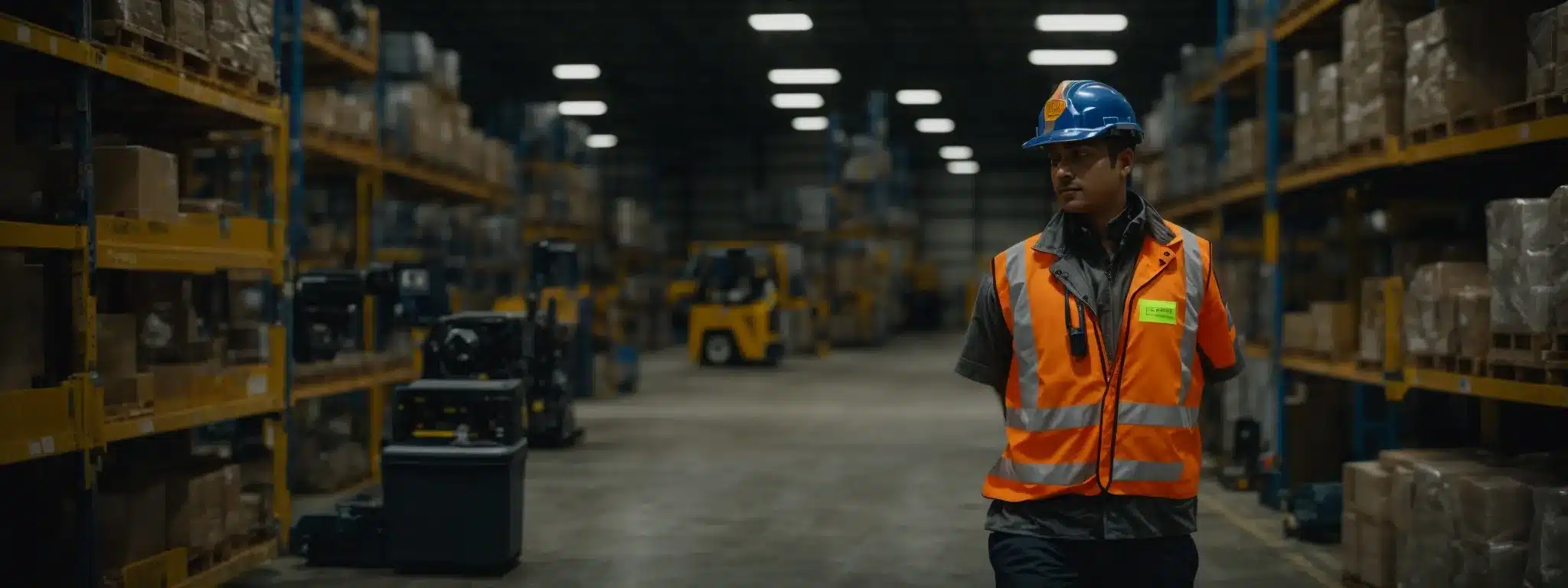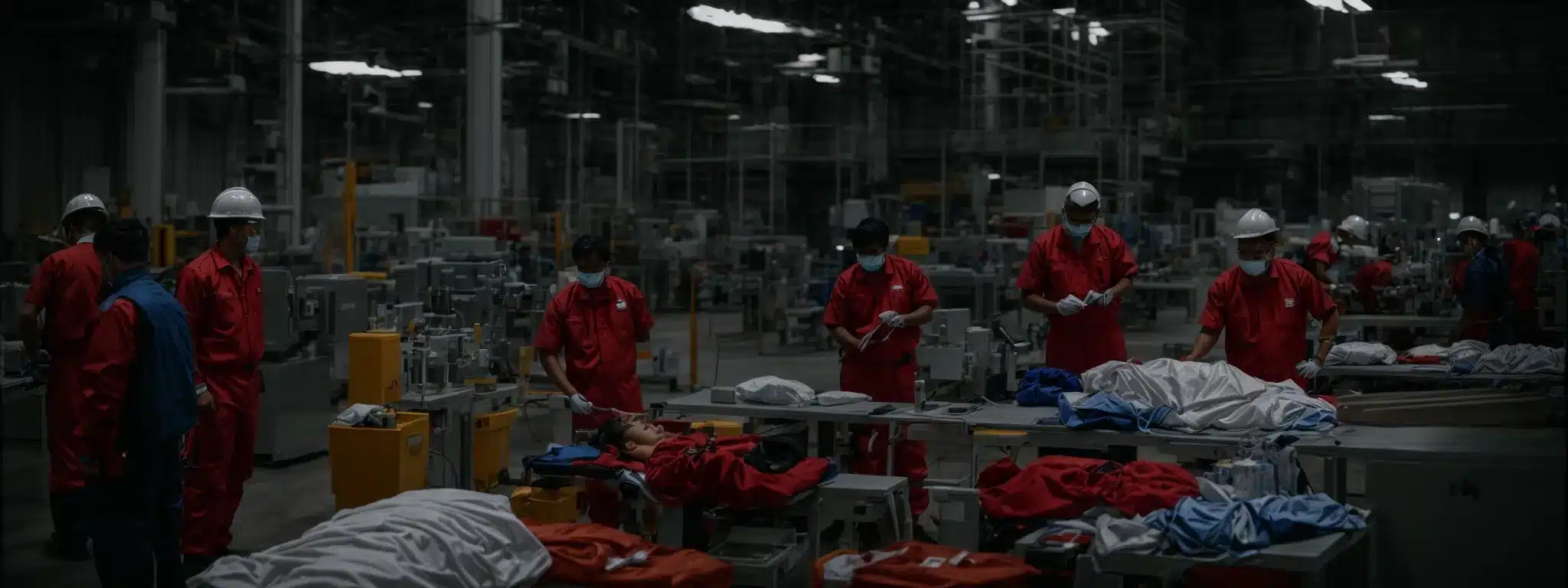Effective Implementation of Injury Prevention Strategies in the Workplace
Ensuring the well-being of employees is a priority for any responsible employer, and this involves taking proactive steps to mitigate workplace hazards.
From the strain injuries caused by repetitive motion to the more dire threat of workplace violence, the risks vary greatly across different settings.
An effective injury prevention program is not just about responding to incidents, but also about preventing them through assessment, training, and culture shifts.
Employers who invest in the safety of their workforce not only protect their employees but also enhance productivity and satisfaction.
Keep reading to discover how companies can implement injury prevention strategies that safeguard everyone from the shop floor to the executive suite.
Key Takeaways
- Employee Engagement in Identifying Hazards Contributes to a Safer Workplace
- Regular Safety Training and Adherence to Industry-Specific Guidelines Are Essential for Accident Prevention
- Acknowledging and Rewarding Safe Behavior Incentivizes a Strong Safety Culture
- Regular Inspections and Updates of Safety Protocols Adapt to Evolving Workplace Conditions
- Integrating New Safety Technologies Can Enhance Injury Prevention and Response
Assessing Risks for Injury in Different Work Environments

Every workplace comes with its unique set of risks and challenges.
From the hustle of high foot traffic areas to the quiet of a secluded office, each presents particular hazards that could lead to workplace injuries or worse, worker fatal events.
Recognizing these risks early, through diligent evaluation and regular risk assessments, plays a pivotal role in injury prevention.
Engaging employees in flagging safety risks fosters an environment where health and safety become a collective responsibility.
Meanwhile, adherence to industry-specific safety standards ensures that an employer’s efforts are not only well-directed but also comply with regulatory guidelines.
This introductory segment sets the stage to explore how businesses can identify potential dangers and mitigate them effectively, nurturing a work environment poised against the unseen threats that often pass unnoticed until an incident unfolds.
Identify Potential Hazards Specific to Your Workplace
Within the walls of any business, keen eyes can spot workplace hazards that spell danger for the unsuspecting individual. Whether it’s a slick floor that invites slips and trips or poorly spaced out workstations that foster strain injuries, these troubles lurk in every corner, calling for urgent attention before they culminate in an unwanted event.
Turning an employer’s focus to employee safety begins with a thorough investigation of the daily routines within their domain. Behemoth machinery, fast-moving vehicles, and stress-inducing deadlines can create a cocktail of risks that no agency would find acceptable, pressing the need for action that sidesteps the path leading to an emergency department.
Conduct Regular Workplace Risk Assessments
Routine workplace risk assessments form the backbone of robust injury prevention schemes. By conducting these audits at regular intervals, employers can uncover latent hazards—from an exposed wire that could spark danger to the emotional strain that might precede incidents of workplace violence.
These assessments empower employees and supervisors alike to document and report areas of concern, streamlining the process for timely intervention and correction. An effective safety standard within an organization is seldom a static one; it adapts, evolves, and thrives on the insights gathered through continuous appraisals of the work environment.
Involve Employees in Identifying Safety Risks
To catalyze the effectiveness of safety protocols, firms are positioning their workers as active participants in spotting dangers. A person who spends their day in the thick of operations often has the best vantage point to notice the subtle, yet significant, safety gaps that might otherwise elude a supervisor’s overview.
By establishing channels for workers to voice concerns, businesses empower their workforce to take ownership of their domain’s safety. This collaborative approach turns each employee into a sentinel, eyeing potential threats and sounding the alarm before mishaps turn into injury or tragic workplace homicides:
- Training programs equip employees with the skills to detect and respond to workplace hazards effectively.
- Regular safety meetings create open forums where workers and management can discuss and strategize on violence prevention and accident prevention.
- An anonymous report system encourages employees to communicate safety issues without fear of repercussion.
In this concerted effort, the company cultivates a work environment where every worker, from front-line staff to managers, becomes instrumental in weaving a tighter safety net around themselves and their colleagues.
Use Industry-Specific Guidelines to Assess Risks
Customized approaches are key to addressing the unique profiles of various industries, and leveraging industry-specific guidelines is critical. These guidelines, often set forth by authorities like the Occupational Safety and Health Administration, provide a tailored rubric reflecting the distinct nature of risks associated with particular sectors, from construction to healthcare.
Employers who align their risk assessments with these targeted guidelines ensure a higher relevancy and efficiency in their safety practices. By doing so, they not only uphold a safety standard that resonates with their specific work environment but also affirm their commitment to safeguarding their employees against the nuanced dangers that their particular industry presents.
Creating a Company-Wide Safety Culture

Building a culture of safety within a workplace is about cultivating a shared commitment from every corner of the organization.
It starts by compelling leadership to set the tone, underscoring the importance of safety priorities that echo throughout the workplace.
To weave these priorities into the company’s fabric, it must integrate safety training as an ongoing narrative, not a one-off event.
Celebrating and rewarding staff who embody safe practices energizes the workforce and reinforces positive behavior.
Furthermore, the cultivation of a transparent atmosphere, where safety concerns can be raised without trepidation, is crucial for preempting risks and nurturing a proactive safety culture that benefits everyone involved.
These strategies, together, are the building blocks for a safer, more aware, and engaged workplace.
Engage Leadership in Promoting Safety Priorities
Engaging leadership in promoting safety priorities is a transformative step that imprints the importance of a vigilant work environment onto the company’s ethos. As leaders model and reinforce the practices that protect their teams, they establish a standard for everyone to emulate.
Chiefs and managers become the driving force behind a shift towards a robust safety culture, a move that resonates deeply across all company levels. This top-down involvement demonstrates a commitment to the welfare of every individual within the organization, bolstering trust and encouraging a unified approach to safety.
Implement Safety Training as a Continuous Process
Embedding safety into the DNA of a company requires turning training programs into a regular part of work life. Regularly updated and repeated, these programs keep safety at the forefront of every employee’s mind, honing their abilities to spot and evade risks daily.
In embracing continuous safety training, the employer acknowledges that the work environment and hazards evolve, and so must the strategies to manage them. Keeping training fresh and relevant equips workers with the tools to adapt to new threats, bolstering the overall resilience of the workforce:
| Steps to Safety | Details |
|---|---|
| Regular Training Sessions | Periodic updates to safety training curricula to reflect current workplace hazards. |
| Employee Engagement | Actively involving employees in safety discussions and feedback loops to enhance relevance and effectiveness of training. |
| Management Involvement | Leaders and supervisors partake in training to lead by example and reinforce a culture of safety. |
Recognize and Reward Safe Behavior Among Staff
Recognizing and rewarding safe behavior is a powerful tool in reinforcing the importance of workplace safety. When an employee consistently demonstrates adherence to safety protocols and acts proactively to prevent accidents, acknowledging their efforts with rewards can amplify their influence within the company. These positive reinforcement actions serve as a catalyst, inspiring others to follow suit and integrate safe practices into their everyday routines.
These acknowledgments send a clear message: the employer values the wellbeing of its people and appreciates the dedication to maintaining a secure work environment. Rewards can take various forms, from verbal commendation during meetings to tangible incentives, making safety achievements a celebrated aspect of the company’s culture:
- Public Recognition: Honoring safe behavior in front of peers during company meetings or through internal newsletters.
- Safety Awards: Distributing certificates, bonuses, or other tokens of appreciation for zero-incident records or innovative safety ideas.
- Staff Celebrations: Organizing events to celebrate milestones in safety, uniting the team in mutual achievements.
Encourage Open Communication About Safety Concerns
A pivotal component of a robust safety culture is the establishment of open lines of communication where employees feel comfortable discussing concerns about potential hazards. This transparency allows for the swift detection and management of risks, ensuring that every voice has the power to initiate change and push for a safer workplace.
Management must extend beyond mere encouragement and actively nurture an environment where discussions about safety are not only welcomed but expected. When employees know that their insights are highly valued and can lead to actionable changes, it strengthens the collective resolve to maintain a secure and healthy work setting for all.
Designing and Implementing Safety Protocols

Within the diverse spectrum of work environments, crafting and executing safety protocols is vital to championing employee well-being and injury prevention.
As companies strive to conceive clear-cut procedures, compliance with safety standards emerges as a critical pillar to fortify workplace security.
Equipping workers with the necessary safety gear and insight stands as an unequivocal necessity, ensuring every individual is prepared to confront the risks inherent to their responsibilities.
Beyond simply instituting these measures, the dynamic nature of workplace hazards demands that safety protocols undergo regular reviews and enhancements.
This approach fosters a responsive and proactive stance against the ever-changing landscape of occupational risks.
Develop Clear Injury Prevention Procedures
Clear-cut injury prevention procedures are the blueprint for safety within any organization. By outlining specific steps workers should take to mitigate risks, a company establishes a systematic approach that leaves little room for ambiguity: each employee understands the protocol and knows how to act in the face of potential dangers.
| Action | Purpose | Outcome |
|---|---|---|
| Delineate Emergency Paths | To provide a quick exit route during emergencies | Minimized risk during evacuation |
| Regular Equipment Checks | To ensure all safety gear and machinery are in working order | Prevention of accidents due to equipment failure |
| Document Incident Reports | To record and analyze any accidents or near-misses | Continuous improvement of safety protocols |
Incorporating these procedures into daily routines fortifies a work environment against the onset of workplace accidents. Meticulously crafted plans that undergo routine evaluations not only adhere to safety standards but also enhance the overall culture of prevention, making every workplace a safer arena for its denizens.
Ensure Compliance With Regulatory Safety Standards
Staying aligned with regulatory safety standards is not merely a choice but a fundamental obligation for employers. It safeguards businesses from legal repercussions and, more importantly, ensures that every worker is protected by a baseline of safety protocols recognized by authoritative bodies such as the Occupational Safety and Health Administration (OSHA).
By integrating these standards into the core of workplace policies, employers create a framework that guides the development of a robust safety infrastructure: one that addresses specific occupational hazards and promotes the well-being of its employees. This integration is a critical step in fortifying employee safety and fostering a resilient, hazard-aware community within the workplace:
- Implementing procedures that meet or exceed established safety guidelines.
- Continually updating policies to reflect regulatory changes and industry advancements.
- Engaging in regular inspections to ensure ongoing compliance with safety regulations.
Equip Workers With the Necessary Safety Tools and Gear
Equipping workers with the correct safety tools and gear is a core element in sustaining a workplace that prioritizes employee safety. Every person on the job should have access to the necessary items, from hard hats and high-visibility jackets to ergonomic furniture that prevents strain injuries, ensuring a work environment geared toward injury prevention.
To maintain safety standards, employers must routinely evaluate the condition of safety equipment and replace it promptly when it’s no longer effective. This ongoing investment reflects the company’s dedication to its workforce’s health and safety and its willingness to take concrete steps towards accident prevention.
Regularly Review and Update Safety Protocols
Safety protocols in the workplace are not meant to be static; they require ongoing scrutiny to align with the ever-shifting dynamics of work conditions. Regular evaluations allow for the identification of new risks and the incorporation of innovative prevention techniques, ensuring protocols remain effective and current.
An employer committed to health and safety understands the necessity of adapting injury prevention strategies to reflect technological advances, shifts in employee roles, and emerging workplace hazards. This proactive stance on reviewing and amending safety protocols ensures a company is continuously fortifying its defenses against potential injuries and accidents.
Integrating Technology for Injury Prevention

In a world where technological advancements continually redefine what’s possible, integrating these innovations into the realm of occupational safety presents vast opportunities.
Employers are now turning to state-of-the-art ergonomic tools, sophisticated safety monitoring systems, and cutting-edge wearable technology to elevate their injury prevention strategies.
These technological solutions not only enhance the ability to detect and respond to imminent risks but also support a proactive posture in managing the health and safety challenges that today’s dynamic work environments present.
As we delve deeper into each of these topics, it’s clear that the intelligent application of technology is revolutionizing how employers ensure a safer and more secure workplace for their teams.
Utilize Ergonomic Tools and Equipment
Incorporating ergonomic tools and equipment into the workplace transcends traditional safety measures by addressing the root of many work-related strain injuries. By customizing workstations to fit the needs of the individual worker, employers actively mitigate the risk of injury and foster long-term employee wellness.
Advancements in ergonomic design have seen the introduction of chairs, desks, and tools that align with the body’s natural posture, reducing the stress on joints and muscles: these efforts are critical in sustaining a healthy and productive work environment.
- Ergonomic chairs support proper spine alignment, reducing back strain.
- Adjustable desks allow workers to alternate between sitting and standing, minimizing lower back compression and improving circulation.
- Specialized tools designed for ease of use reduce the need for excessive force, preventing overuse injuries.
Implement Safety Monitoring and Alert Systems
Employing safety monitoring and alert systems is a modern approach that reinforces the traditional safeguards in the workplace. These systems, ranging from environmental sensors to real-time location trackers, provide an extra layer of security by swiftly identifying potential hazards and alerting the workforce to take immediate action.
The integration of these systems also aids in the swift response to any incident that might occur, ensuring timely evacuation and access to emergency services. Sophisticated networks that connect devices and centralize data are pivotal in the prompt dissemination of critical safety information:
- Enhanced real-time hazard detection through sensor technology minimizes the reaction time to threats.
- Centralized communication systems allow for rapid transmission of alerts to all workers simultaneously.
- GPS and wearable devices offer precise location tracking for a quick response in event of an emergency.
Adopt Wearable Tech for Real-Time Hazard Detection
Smart wearable technology is transforming the landscape of workplace safety by providing individuals with real-time data on potential hazards. Employees outfitted with smartwatches, badges, or other wearable devices can receive immediate alerts related to environmental dangers like toxic gas exposure or equipment malfunctions, allowing for swift action and mitigation of risk.
Moreover, the use of these wearables facilitates the monitoring of worker vitals and ergonomic posture, offering an early warning system for signs of strain or stress. This proactive measure helps prevent long-term health issues and ensures that employees can work in the safest conditions possible, reducing overall workplace injuries.
Responding to Injuries and Altering Strategies Accordingly

Reacting swiftly and judiciously to injuries at work is crucial for minimizing their impact and preventing future incidents.
A successful injury response protocol not only addresses immediate medical needs but also sets the foundation for continuous improvement of safety measures.
Through thorough analysis of injury reports, organizations can discern patterns and pinpoint underlying causes, using this valuable data to refine and adjust their prevention strategies.
Emphasizing a cycle of evaluation, intervention, and adaptation fosters a dynamic approach to workplace safety, ensuring that injury prevention efforts remain effective and responsive to the evolving needs of the work environment.
Establish a Protocol for Immediate Injury Response
An immediate injury response protocol is imperative for managing on-site accidents effectively. It ensures that every employee knows exactly what to do and whom to contact, reducing the time between the injury event and professional medical care.
Integration of quick-response measures, such as first-aid stations and an established line to summon medical assistance, can significantly reduce the impacts of workplace injuries. A designated response team trained specifically for these scenarios becomes a pivotal part of an organized and efficient recovery process.
Analyze Injury Reports to Identify Trends and Solutions
Analyzing injury reports is a strategic approach that enables employers to identify common trends and pinpoint repetitive risk factors. This critical evaluation of documented cases forms the basis for developing targeted solutions to prevent similar occurrences in the future.
Employers can turn these insights into action by implementing refined safety strategies that address the root causes of workplace injuries. By doing so, they create a feedback loop that continuously improves the safety protocols and supports a safer work environment for every employee:
- Alter training programs to cover identified risks more comprehensively.
- Update safety equipment and procedures in areas where incidents are frequent.
- Revise emergency response plans to incorporate lessons learned from past events.
Adjust Prevention Strategies Based on Injury Data
In shifting prevention strategies, injury data serve as the compass guiding workplace safety initiatives. Employers who scrutinize this intel can adjust their tactics to specifically target the most pressing risks, ensuring a more resilient shield is cast over their workforce.
Utilizing injury statistics, companies can decisively pinpoint which prevention methods are effective and which require fine-tuning: this strategic approach optimizes safety resources and solidifies the overall health of the work environment.
- Analyze patterns from injury reports to direct focus on prevalent issues.
- Infuse new prevention methodologies based on empirical data trends.
- Continuously evolve safety training to keep pace with emerging threats.
Continuously Educating Employees on Safety Practices

Developing a safety-conscious workforce is essential in the battle against workplace injuries, and ongoing education serves as the arsenal.
Introducing employees to new safety technologies equips them with modern tools to identify and respond to hazards.
Conducing regular drills ingrains swift and effective emergency response behaviors while distributing educational materials anchors the importance of injury prevention.
Together, these educational strategies combine to strengthen the team’s capability to predict, prevent, and manage injury risks, leading to a safer and more informed workplace.
Offer Training Sessions on New Safety Technology
Keeping abreast with emerging safety technologies requires that employees receive regular training sessions, enabling them to effectively leverage these tools within their work environment. Employers must facilitate educational workshops that demystify new devices and software, allowing workers to become proficient operators of state-of-the-art safety apparatus that could potentially save lives.
Training on new safety technology garners best results when tailored to both the unique needs of the work environment and the varied learning styles of individuals. Such targeted training ensures that every worker not only comprehends technological functionalities but also feels confident in applying them to real-world situations that call for swift and informed responses to hazards.
Schedule Regular Safety Drills and Emergency Response Exercises
Scheduling regular safety drills catalyzes the reflexes employees need in times of crisis. These drills, staged with realistic scenarios, instill the necessary survival instincts and bolster familiarity with emergency protocols, ensuring a calculated, prompt response should an actual emergency erupt.
Emergency response exercises serve as a critical test of workplace preparedness, unveiling any weaknesses in the current safety strategy. Probing the effectiveness of escape routes, communication systems, and employee readiness, these exercises offer vital feedback that empowers a company to refine its safety procedures and amplify its crisis response efficacy.
Provide Educational Materials on Injury Prevention in the Workplace
Disseminating educational materials is an essential component in empowering employees with knowledge on injury prevention. These resources, such as safety manuals, infographics, and quick-reference guides, are instrumental in reinforcing training messages and providing accessible information for reference at a moment’s notice.
Employers play a key role in ensuring that these educational materials are comprehensive yet easy to understand, aiding in their practical application within the workplace. Tailored to address the specific risks of a given environment, they form an integral part of the broader effort to embed safety consciousness in the culture of the company.







